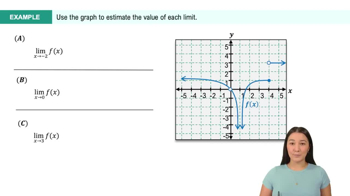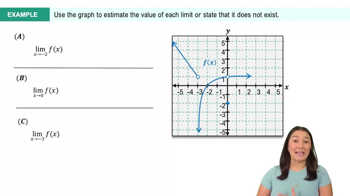Table of contents
- 0. Functions7h 52m
- Introduction to Functions16m
- Piecewise Functions10m
- Properties of Functions9m
- Common Functions1h 8m
- Transformations5m
- Combining Functions27m
- Exponent rules32m
- Exponential Functions28m
- Logarithmic Functions24m
- Properties of Logarithms34m
- Exponential & Logarithmic Equations35m
- Introduction to Trigonometric Functions38m
- Graphs of Trigonometric Functions44m
- Trigonometric Identities47m
- Inverse Trigonometric Functions48m
- 1. Limits and Continuity2h 2m
- 2. Intro to Derivatives1h 33m
- 3. Techniques of Differentiation3h 18m
- 4. Applications of Derivatives2h 38m
- 5. Graphical Applications of Derivatives6h 2m
- 6. Derivatives of Inverse, Exponential, & Logarithmic Functions2h 37m
- 7. Antiderivatives & Indefinite Integrals1h 26m
1. Limits and Continuity
Introduction to Limits
Problem 35a
Textbook Question
Postage rates Assume postage for sending a first-class letter in the United States is $0.47 for the first ounce (up to and including 1 oz) plus $0.21 for each additional ounce (up to and including each additional ounce).
a. Graph the function p=f(w) that gives the postage p for sending a letter that weighs w ounces, for 0<w≤3.5.
 Verified step by step guidance
Verified step by step guidance1
Step 1: Understand the problem. We need to graph the function p = f(w) that represents the postage cost p for a letter weighing w ounces, where 0 < w ≤ 3.5. The cost is $0.47 for the first ounce and $0.21 for each additional ounce.
Step 2: Define the function. For 0 < w ≤ 1, the cost is $0.47. For 1 < w ≤ 2, the cost is $0.47 + $0.21 = $0.68. For 2 < w ≤ 3, the cost is $0.68 + $0.21 = $0.89. For 3 < w ≤ 3.5, the cost is $0.89 + $0.21 = $1.10.
Step 3: Identify the type of function. This is a piecewise function, where each piece is constant over the intervals (0, 1], (1, 2], (2, 3], and (3, 3.5].
Step 4: Plot the graph. On the x-axis, represent the weight w in ounces, and on the y-axis, represent the postage cost p in dollars. Plot horizontal line segments for each interval: from (0, 1] at $0.47, from (1, 2] at $0.68, from (2, 3] at $0.89, and from (3, 3.5] at $1.10.
Step 5: Indicate the endpoints. Use closed circles at the right endpoints of each interval to indicate that the value is included, and open circles at the left endpoints (except for the first interval) to indicate that the value is not included.
Recommended similar problem, with video answer:
 Verified Solution
Verified SolutionThis video solution was recommended by our tutors as helpful for the problem above
Video duration:
5mPlay a video:
Was this helpful?

 6:47m
6:47mWatch next
Master Finding Limits Numerically and Graphically with a bite sized video explanation from Callie
Start learning





